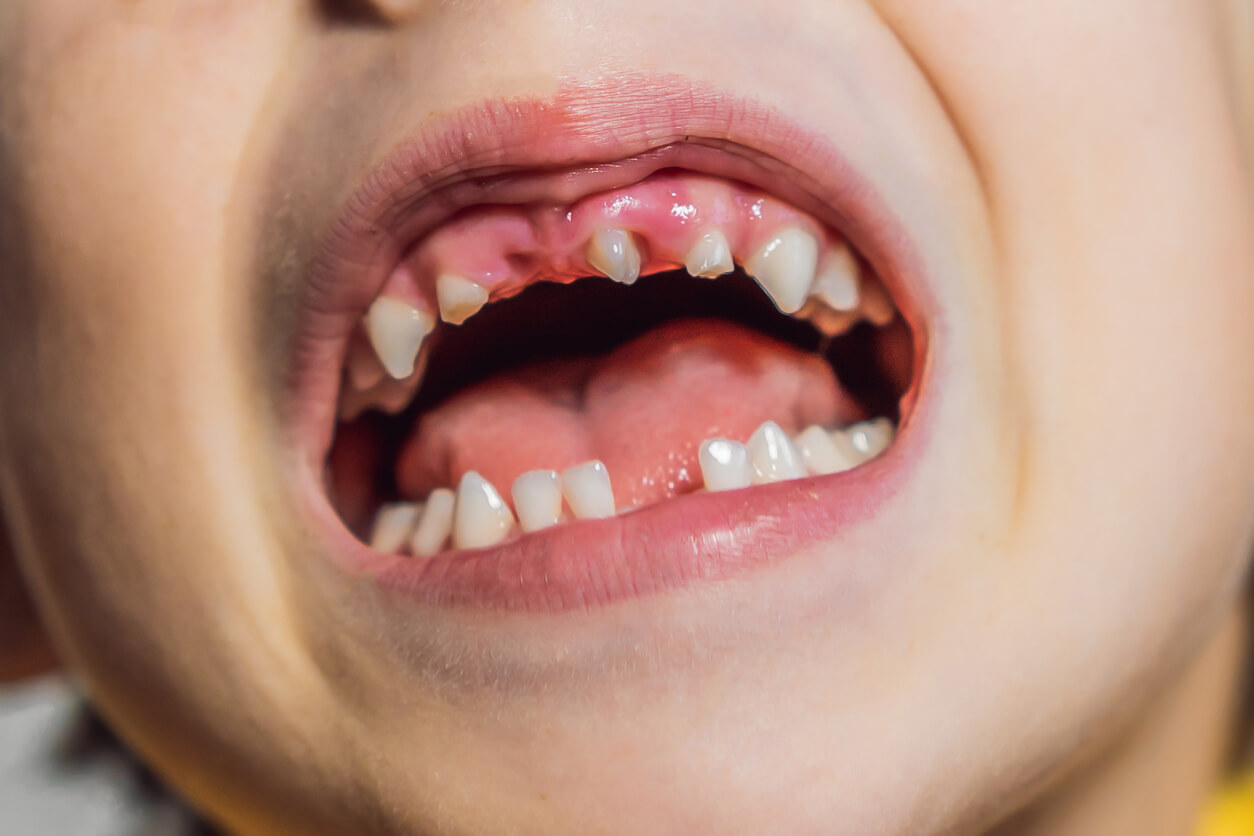Cleidocranial Dysplasia: How Does It Affect the Mouth?

Cleidocranial dysplasia is a rare disease that affects different parts of the body, including the mouth. In particular, it alters the development of bones and teeth, giving the person a particular appearance.
Although it’s a rare genetic disorder, it has recently gained visibility thanks to actor Gaten Matarazzo, who plays Dustin Henderson in the Netflix series Stranger Things, who suffers from the disease.
The manifestations and severity of the condition vary in each patient. In this article, we’ll tell you everything you need to know about cleidocranial dysplasia and its impact on the mouth.
What is cleidocranial dysplasia?
Cleidocranial dysplasia, also known as cleidocranial dysostosis, is a genetic disorder that affects bone and tooth development. Due to a variation in a gene located on chromosome 6, the cells responsible for bone formation are altered.
The name of the disease comes from the Greek words cleido (clavicle) and kranion (head). So, being a type of dysplasia, it refers to the abnormal formation of the skull and clavicles, two characteristic manifestations of this disorder.
Genetic mutation is the main cause of this condition, but not all people who have the alteration in their chromosome have cleidocranial dysplasia. There’s an autosomal dominant inheritance that’s transmitted between generations. Thus, several members of the same family may have the disease.
In any case, in 40% of cases, the disorder appears spontaneously, with no previous history. Its frequency is very low, about one case per one million people.

Manifestations of cleidocranial dysplasia
People with cleidocranial dysplasia have a characteristic physical appearance and manifestations in the mouth. We’ll tell you the main symptoms of this disorder below:
- Short stature. Adult females are less than 5 feet tall and males are less than 5’3″ tall.
- Short limbs and filiform fingers.
- Hypoplasia or aplasia of the clavicles. That is, these bones are very small or non-existent. This causes the shoulders to be droopy and the thorax to be narrow.
- Open cranial sutures. They can persist throughout life in this way. However, this isn’t associated with problems in cognitive development.
- Hypertelorism. This is when the eyes are farther apart.
- Widened frontal and parietal bones of the skull. The forehead looks wide and bulging.
- Mouth with bone malformations. These affect the jaws, palate, and teeth, causing problems with biting, chewing, and speaking.
- Teeth with anomalies and developmental alterations. Hypoplasias, agenesis, supernumerary teeth, and delayed eruption are frequent. Malpositions, crowding, and malocclusions are also common.
- Skeletal problems in the spine, such as scoliosis (lateral deviation of the spine) or kyphosis (hypercurvature).
- Lower extremities with alterations. For example, they may have genu valgum (X-shaped knees) and flat feet.
Associated complications
There are some complications secondary to cleidocranial dysostosis. These can affect the sufferer’s life circumstantially or permanently. The most common are the following:
- Recurrent or chronic infections of the respiratory tract
- Apnea sleep disorder
- Deafness
- Mild motor disability
- Abnormalities in the sternocleidomastoid, trapezius, deltoid, and pectoralis major muscles
- Increased risk of bone fractures
- Early osteoporosis
In addition, it’s common for these patients to have to be delivered by cesarean section because the larger cephalic volume makes pelvic delivery difficult.
Consequences of cleidocranial dysplasia in the mouth
The oral and dental alterations produced by cleidocranial dysplasia can interfere with the patient’s quality of life, especially during childhood. Delayed eruption of teeth, both in the primary and permanent dentition, is one of the characteristic symptoms of this disorder. Delayed eruption affects the chewing, eating, appearance, and speech of children.
There may also be problems with the shedding and loss of baby teeth at the time of replacement. Permanent teeth are often slow to erupt and there may be some missing or, conversely, extra teeth.
The appearance of cysts in the jaw bones is another situation that’s related to cleidocranial dysostosis. In addition, the teeth may have anomalies in their roots or crowns. The alteration of the shape, size, and appearance of the teeth produces occlusion problems, affects the appearance of the smile, and can predispose them to the accumulation of bacterial plaque and the development of caries.
Problems in the development of the bones of the mouth can occur, causing very narrow or cleft palates and jaws that fail to relate properly.
This’s why dental visits and checkups become so important in these patients.

Treatment for cleidocranial dysplasia and mouth conditions
There’s no treatment that cures and cleidocranial dysostosis, but there are therapies aimed at counteracting the manifestations associated with the disorder.
The disease is diagnosed through physical examination, x-rays, and genetic studies that confirm the problem in chromosome 6. It’s even possible today to reach a prenatal diagnosis through routine ultrasound scans during pregnancy.
Treatments may include orthopedics, orthodontics, tooth extractions, or surgery. If some teeth are missing, their restitution with prosthetic rehabilitations according to the patient’s age will be necessary.
The prognosis of this disorder is usually good. With proper professional support, the patient can lead a normal life without major difficulties.
Support is key
Cleidocranial dysplasia is a rare condition that affects the bones and mouth of the patient. Although there’s no cure for this disease, early treatments help to minimize the symptoms.
The support of the family and a team of committed professionals is fundamental. With their help, these patients are able to lead an almost normal lifestyle.
All cited sources were thoroughly reviewed by our team to ensure their quality, reliability, currency, and validity. The bibliography of this article was considered reliable and of academic or scientific accuracy.
- Montes Carmona, J. F., Albarracín Arjona, B., Rodríguez Jara, P. M., López Martos, R., Fakih Gómez, N., & Hernández Guisado, J. M. (2016). Disostosis cleidocraneal. Revista Española de Cirugía Oral y Maxilofacial, 38(4), 238-239.
- González-Burgos, O. M., Martínez-Mendoza, N. J., & Vera-Argüelles, G. Displasia cleidocraneana: caso clínico con hallazgos prenatales y seguimiento posnatal.
- Hassi, J., Izquierdo, C., & Narea, G. (2019). Displasia Cleidocraneal: Manejo ortodóncico y quirúrgico, seguimiento a 10 años. Revista clínica de periodoncia, implantología y rehabilitación oral, 12(2), 109-112.
- Granado-Abasto, L. A., Llaguno-Rubio, J. M., Fiori-Chíncaro, G. A., & Medina-Ocampo, P. E. (2021). Estudios de imagen utilizados como ayuda en el diagnóstico de displasia cleidocraneal. Una revisión. Revista Científica Odontológica, 9(2), e063-e063.
- Martinovic-Guzmán, G., Vergara-Iturriaga, M., Alister-Herdener, J. P., & Manterola, C. (2019). Queratoquiste Odontogénico en un Paciente con Displasia Cleidocraneal: reporte de un Caso. International journal of odontostomatology, 13(2), 189-194.
- Peralta-Dzib, Á., Sansores-Ambrosio, F., Loria-Mondragón, T., Minaya-Sánchez, M., Casanova-Rosado, A., & Casanova-Rosado, J. (2020). Cleidocraneal dysostosis at three years of orthopedic treatment. Revista de la Asociación Dental Mexicana, 77(4), 222-226.
- Rivera, A. D., Barajas, U. T., Moreno, N. V., López, J. C., & Cervantes, M. A. (2018). Tooth retention management in a patient with cleidocranial dysplasia. Revista Mexicana de Ortodoncia, 6(2), 105-112.
This text is provided for informational purposes only and does not replace consultation with a professional. If in doubt, consult your specialist.








